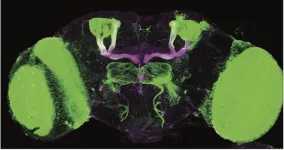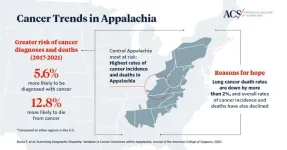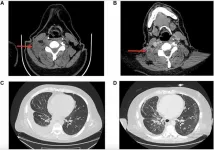(Press-News.org) Alcohol use disorder, which affects over 10% of Americans, can lead to persistent and serious insomnia. Difficulties falling asleep and staying asleep can last even after months of sobriety, increasing the risk of relapse. But treating withdrawal-related insomnia is difficult, partly because what’s going on in the brain in this condition remains largely mysterious.
Now, research in fruit flies has identified specific brain signals and groups of brain cells that are involved in alcohol-induced insomnia. This work could ultimately lead to targeted treatments for alcohol-related sleep loss, helping people recover from alcohol use disorder.
“The effects of alcohol on sleep seem to be localized to a particular cell type in the brain, which is not something that’s ever been shown before,” says Maggie Chvilicek, graduate researcher in neuroscience at the University of Utah and lead author on the study. She adds that these cells often do similar things in flies and humans. “The mechanism that we identified is something that very likely could also exist in a mammalian brain.”
The results are published in Current Biology.
A rebound effect
The researchers noticed that alcohol affected fruit flies much like it affects humans. When flies received a high dose of alcohol, they took longer to fall asleep and were more likely to wake during the night, even several days after the alcohol left their system.
Crucially, the researchers found, the effects of alcohol on sleep depended on dose—and how one might expect. In both flies and humans, a small amount of alcohol acts like a stimulant, increasing feelings of energy and activity levels, while higher levels slow down thinking and reaction time and can cause unconsciousness. But a smaller alcohol dose that made flies hyperactive didn’t prevent them from sleeping normally. In contrast, a bigger dose of alcohol disrupted sleep for days.
This meant that something about the activity-dampening effects of alcohol was interfering with sleep. Chvilicek suspects this may be due to a “rebound” effect, in which reducing brain activity with alcohol causes neurons to become overactive after the fact.
A brain signal called acetylcholine, which plays a key role in memory and motivation, appears to be key to alcohol’s negative impacts on sleep, the research team found. When they reduced acetylcholine signaling, it exacerbated the effects of alcohol on sleep, such that even a low dose of alcohol led to long-lasting insomnia.
Targeting specific brain cells
The team used genetic tools to change the activity of specific brain cells, narrowing down on the particular subset of acetylcholine-producing neurons that seem to be implicated in alcohol-induced sleep disruption.
Reducing acetylcholine signaling within this small set of brain cells again made flies more sensitive to low doses of alcohol, taking longer to fall asleep and waking up more often.
The neurons are in a region of the fly brain which is involved in learning and memory. It functions in many ways like the human hippocampus, where acetylcholine signaling also plays a major role.
One important caveat is that turning off that group of cells doesn’t cause sleep deficits on its own—flies must also be exposed to alcohol to develop sleep symptoms, meaning that something more complicated must be going on. “It’s not just a black-and-white binary of the cells being on or off,” Chvilicek says. “It seems like alcohol is playing a specific role in what’s happening in those cells.”
Toward better treatments
The researchers hope their work ultimately leads to more effective treatments for people in withdrawal. Most sleep medicines act on a broad swath of cells throughout the brain, which increases the risk of addiction and unhealthy side effects. “By identifying a much smaller, more discrete population of cells,” Chvilicek says, “we can theoretically develop much more targeted interventions that really focus on the problem that we’re trying to address.”
Establishing that fruit flies can be used to study alcohol-induced insomnia also allows for much more in-depth study of this condition. “There’s so much mechanistic information that can be gleaned because we have this model,” Chvilicek says.
As a next step, Adrian Rothenfluh, PhD, associate professor of psychiatry at the University of Utah and senior author on the study, adds that the lab plans to explore which genes are involved in alcohol-induced insomnia. “We’ve shown multiple times that the same conserved genes regulate alcohol-induced behavior in flies and humans,” he explains. “We are now in a prime position to identify genetic mechanisms that affect alcohol-induced insomnia.”
###
These results published on February 6 in Current Biology as “Alcohol induces long-lasting sleep deficits in Drosophila via subsets of cholinergic neurons.”
The research was supported by the Huntsman Mental Health Institute, the University of Utah Molecular Medicine Program, and the NIH: the National Institutes of Diabetes and Digestive and Kidney Diseases (R01DK110358), on Drug Abuse (K01DA058919), and on Alcohol Abuse and Alcoholism (F31AA030209, K01AA029200, R01AA030881, R01AA019536, and R21AA031795).
END
Research in fruit flies pinpoints brain pathways involved in alcohol-induced insomnia
2025-02-06
ELSE PRESS RELEASES FROM THIS DATE:
Cancer diagnoses and deaths are declining in Appalachia but remain significantly higher compared to other US regions
2025-02-06
Key Takeaways:
Appalachia is not uniform: There are important distinctions in cancer diagnoses and deaths among different regions of Appalachia, with certain areas of Central Appalachia experiencing the highest rates of cancer incidence and deaths among the greater Appalachian region.
Higher death rates from cancers that can be caught early with screening: Although the region has improved in screening rates, people in Appalachia still die more frequently from cancers that can be caught early with routine screening than elsewhere in the United States.
Reason for hope: Research can pave the way for targeted interventions that can reduce these ...
Why some heavy drinkers develop advanced liver disease, while others do not
2025-02-06
LOS ANGELES — Why do some people who consume a few glasses of alcohol a day develop advanced liver disease while others who drink the same amount don’t?
The answer may lie in three common underlying medical conditions, according to a new study published in Clinical Gastroenterology and Hepatology from Keck Medicine of USC. The research found that heavy drinkers with either diabetes, high blood pressure or a high waist circumference are as much as 2.4 times more likely to develop advanced liver disease.
“The results ...
OmicsFootPrint: Mayo Clinic’s AI tool offers a new way to visualize disease
2025-02-06
ROCHESTER, Minnesota — Mayo Clinic researchers have pioneered an artificial intelligence (AI) tool, called OmicsFootPrint, that helps convert vast amounts of complex biological data into two-dimensional circular images. The details of the tool are published in a study in Nucleic Acids Research.
Omics is the study of genes, proteins and other molecular data to help uncover how the body functions and how diseases develop. By mapping this data, the OmicsFootPrint may provide clinicians and researchers with a new way to visualize ...
New genetic mutation linked to drug resistance in non-small cell lung cancer patient
2025-02-06
“Here we present a case of a patient with stage IV CD-74-ROS1 fusion NSCLC discovered initially with RNA next generation sequencing (NGS) who acquired resistance to lorlatinib after 6 months on therapy through a novel RUFY1-RET fusion, detected only through RNA NGS.”
BUFFALO, NY - February 6, 2025 – A new case report was published in Volume 16 of Oncotarget on February 5, 2025, titled “Acquired RUFY1-RET rearrangement as a mechanism of resistance to lorlatinib in a patient with CD74-ROS1 rearranged non-small cell lung cancer: A case report."
In this case report, Jenny L. ...
Single-photon LiDAR delivers detailed 3D images at distances up to 1 kilometer
2025-02-06
WASHINGTON — Researchers have designed a single-photon time-of-flight LiDAR system that can acquire a high-resolution 3D image of an object or scene up to 1 kilometer away. The new system could help enhance security, monitoring, and remote sensing by enabling detailed imaging even in challenging environmental conditions or when objects are obscured by foliage or camouflage netting.
“Our system uses a single-photon detector approximately twice as efficient as detectors deployed in similar LiDAR systems ...
Fear of breast cancer recurrence: Impact and coping with being in a dark place
2025-02-06
INDIANAPOLIS – Breast cancer is the world’s most prevalent cancer. Although earlier detection and targeted treatment have resulted in high survival rates, many breast cancer survivors experience fear of cancer recurrence. For some survivors this fear is occasional, for others it is persistent and often debilitating.
A new study of breast cancer survivors has found this psychosocial challenge impacts almost every important domain of their lives – the emotional, behavioral, cognitive, relational and professional. A larger number of domains was affected, ...
Korea University researchers analysis of income-related disparities in mortality among young adults with diabetes
2025-02-06
Korea University Researchers Analysis of Income-Related Disparities in Mortality Among Young Adults with Diabetes
Type 2 diabetics (T2D) under 40 years of age with low income have a threefold higher risk of mortality
Young people with T2D are more affected by income than elderly people with T2D
The research team of Professor Sin Gon Kim and Professor Nam Hoon Kim of department of internal medicine (Endocrinology and Metabolism) of Korea University Anam Hospital, and Professor Ji Yoon Kim of Samsung Medical Center confirmed that young adults with T2D with low income have 3 times higher mortality ...
Study shows link between income inequality and health and education disparities may drive support for economic reform
2025-02-06
New research forthcoming in Social Psychological and Personality Science shows that when people understand how income inequality creates disparities in healthcare and education access, they become more likely to support policies addressing economic inequality.
Across four studies, the research shows that highlighting connections between income gaps and inequalities in health and education access decreases acceptance of economic disparities and increase support for redistributive actions.
"Research has shown that people often tolerate income inequality. However, our study shows that when people perceive ...
HonorHealth Research Institute’s Chief Medical Officer is recognized by the world’s leading organization for cancer doctors
2025-02-06
SCOTTSDALE, Ariz. — Feb. 6, 2025 — Michael S. Gordon, M.D., Chief Medical Officer of HonorHealth Research Institute, today was named a Fellow of the American Society of Clinical Oncology (FASCO), the world’s leading professional organization for physicians and oncology professionals caring for people with cancer.
“The title of FASCO is a recognition bestowed upon ASCO members who have shown extraordinary dedication for their voluntary efforts that benefit the Society, the specialty of oncology, and most importantly, the patients whom we serve,” according to a letter ...
InsectNet technology identifies insects around the world and around the farm
2025-02-06
AMES, Iowa – A farmer notices an unfamiliar insect on a leaf.
Is this a pollinator? Or a pest? Good news at harvest time? Or bad? Need to be controlled? Or not?
That farmer can snap a picture, use a smartphone or computer to feed the photo into a web-based application called InsectNet and, with the help of machine learning technology, get back real-time information.
“The app identifies the insect and returns a prediction of its taxonomic classification and role in the ecosystem as a pest, predator, pollinator, parasitoid, decomposer, herbivore, indicator ...








